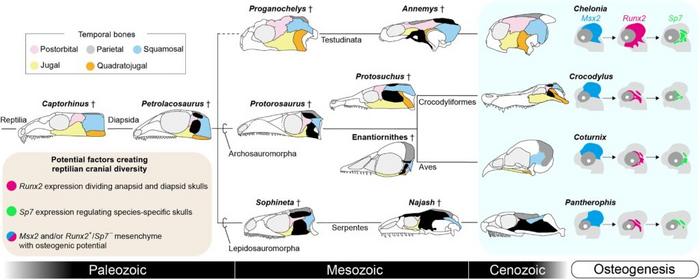The research group led by Associate Professor Masayoshi Tokita (Department of Biology, Faculty of Science) explored the molecular basis generating the diversity of amniote skull morphology, using embryos of several amniote species as materials. The study suggests that the diversity of amniote skull morphology may be brought about by spatiotemporal differences in the expression of three osteogenic genes Msx2, Runx2, and Sp7.The finding provides a basis for understanding how skull morphology has diversified in amniotes, the first vertebrate lineage fully move to land, including human. Furthermore, the finding may provide hints for the development of treatments for congenital diseases that cause abnormalities in human skull morphology. The finding of this research was reported by the American scientific journal Science Advances on November 15, 2023.

Credit: Dr. Masayoshi Tokita
The research group led by Associate Professor Masayoshi Tokita (Department of Biology, Faculty of Science) explored the molecular basis generating the diversity of amniote skull morphology, using embryos of several amniote species as materials. The study suggests that the diversity of amniote skull morphology may be brought about by spatiotemporal differences in the expression of three osteogenic genes Msx2, Runx2, and Sp7.The finding provides a basis for understanding how skull morphology has diversified in amniotes, the first vertebrate lineage fully move to land, including human. Furthermore, the finding may provide hints for the development of treatments for congenital diseases that cause abnormalities in human skull morphology. The finding of this research was reported by the American scientific journal Science Advances on November 15, 2023.
Key Points:
- Amniote skulls have an opening(s) surrounded by bones behind the orbit (temporal region), called the temporal fenestration(s). Amniote skulls are categorized into three conditions: anapsid, synapsid, and diapsid, depending on the number of the temporal arches that boarder ventral side of the temporal fenestrations.
- In this study, the expression patterns of the osteogenic genes Msx2, Runx2, and Sp7 were examined during embryonic skull formation of six reptilian species (three turtle species, two snakes species, and one crocodile species), two avian species, and two mammalian species.
- In the temporal region of reptilian and avian embryos, Msx2 was widely expressed.
- The expression domain of Runx2 was widespread in the temporal region of turtle embryos, whereas in non-turtle reptiles and birds it was restricted to the region excluding the domain where the temporal fenestrations later appear.
- In the temporal region of reptilian and avian embryos, Sp7 was regionally expressed in the area where the bones are later formed. Its expression pattern varied among species.
- In the temporal region of mammalian embryos, Msx2, Runx2, and Sp7 were regionally expressed in the domain where the bones are later formed.
- This study suggests that the diversity of amniote skull morphology may be brought about by spatiotemporal differences in the expression patterns of Msx2, Runx2, and Sp7.
Journal
Science Advances
DOI
10.1126/sciadv.adi6765
Method of Research
Experimental study
Subject of Research
Animals
Article Title
Turtle skull development unveils a molecular basis for amniote cranial diversity
Article Publication Date
15-Nov-2023
COI Statement
Authors have no conflict of interest to disclose.




